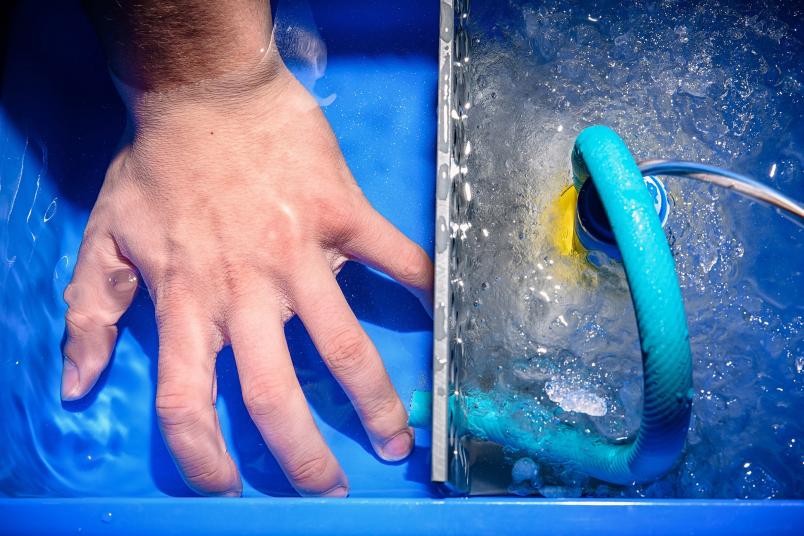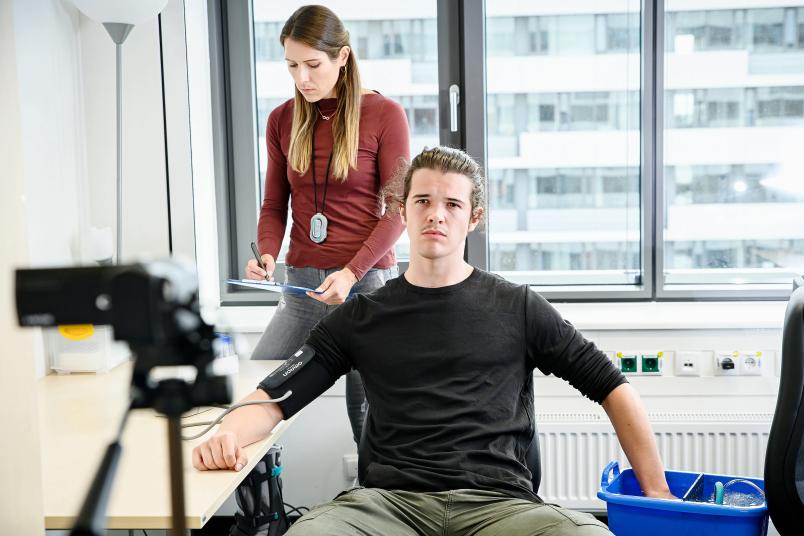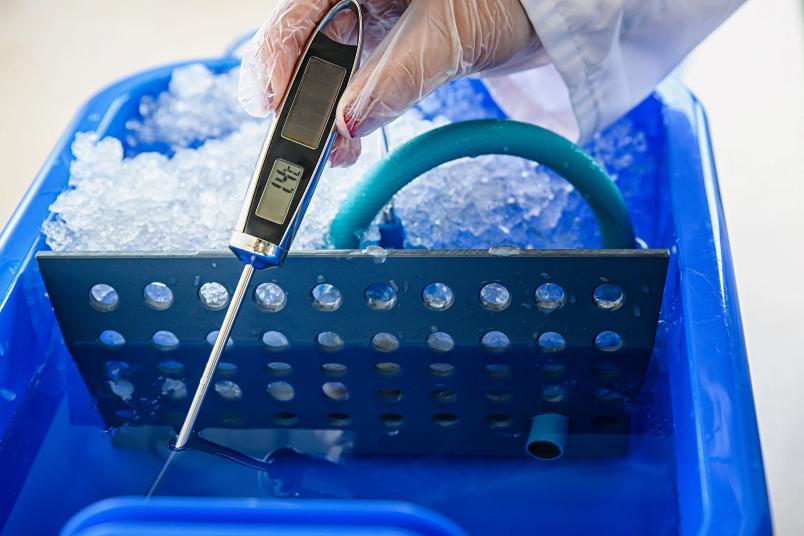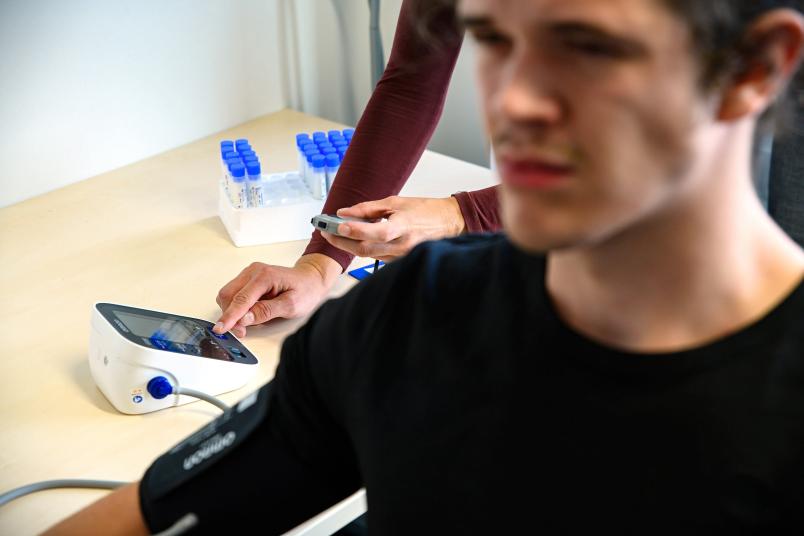
Neuroscience
Three ice-cold minutes
How do men and women regulate their emotions under stress? A new study in cognitive psychology that makes use of the socially evaluated cold-pressor test has answered this question.
The water temperature is zero to two degrees. “Please put your non-dominant hand in the cold water pool. And now look at the camera in front of you,” the instruction says. An engine makes the cold water circulate. After a while, the participant’s hand turns reddish. He distracts himself, lets his gaze wander, clenches a fist. The experimenter doesn’t bat an eyelid and asks him to correct his posture. “Please sit up straight, stretch out your hand and look into the camera.” After a while, the participant is instructed to remove his hand from the water – as are all of the 80 test subjects.
“Our volunteers are supposed to do this for three minutes. I couldn’t stand the cold for so long. It’s quite painful,” as Dr. Katja Langer, a postdoctoral researcher at the Department of Cognitive Psychology, knows from experience. The researcher uses the so-called socially evaluated cold-pressor test to induce stress. “The situation in the lab triggers a physiological and psychological stress response in most participants, and we then examine its effects on various cognitive and emotional processes,” explains Langer. In her latest study, published in Psychoneuroendocrinology, she shows that the impact of stress on cognitive emotion regulation differs between men and women.
When your heart is racing
The response to stress varies from person to person. Some are more easily susceptible to being chronically stressed, even becoming depressed, while others recover from stressful situations quite quickly. “We’re trying to find out which factors may account for these different susceptibilities,” says Langer. Research has shown that there are two main stress systems. “When we’re under stress, our body releases the stress hormone cortisol, for one thing. In addition, our sympathetic nervous system is activated, and that means the neurotransmitters adrenaline and noradrenaline. We feel our heart racing, notice how our blood pressure rises,” explains Langer.

How people function under stress
The Bochum-based researcher is primarily interested in the immediate stress responses. She studies in what way stress affects our cognitive emotion regulation in the short term: that is, our ability to control our feelings through thought. “We’re interested in two cognitive strategies, reappraisal and distraction,” points out Langer. How difficult do we find them when we’re stressed?
The socially evaluated cold-pressor test is meant to provide a better understanding. The experiment described above activates both stress systems in the test subjects. Following the hand bath in cold water, they are shown pictures of negative situations. “They are asked to reframe the situations presented on the pictures, reinterpret them, imagine a positive ending or distract themselves, for example by thinking of another situation that has nothing to do with the picture,” elaborates Langer.
Cognitive reframing of negative situations as positive ones
Before and immediately after the socially evaluated cold-pressor test, the Bochum research team uses questionnaires to ascertain what the participants feel. “We ask about emotions in accordance with the Differential Affect Scale. For example, did the participants feel sadness, anger, disgust, guilt, fear, or even joy or interest?” lists Langer. The researchers also intend to find out how difficult the test subjects found it to hold their hand in ice-cold water and how stressed they felt in the process. “We ask our participants to rate their experience on a scale of 0 to 100,” explains Langer. Their reactions to the picture test are also polled: how excited were you? Did you rate the situations as negative or positive and to what extent? How well did you manage to regulate your emotions?
Blood pressure, saliva and pupil dilation
As an additional, objective measure, Langer records the range of physiological responses. Before, during and after the test, blood pressure and pulse rate are measured to confirm the definite stress response. Moreover, saliva samples are also taken to detect levels of cortisol and the enzyme alpha-amylase. The latter is associated with the release of adrenaline and noradrenaline. In addition, the pupil dilation in each case is recorded to measure emotion regulation outcomes. Langer explains, “Pupil dilation is a well-established measure of arousal and cognitive effort. The more emotionally aroused I am or the more focused I am on reevaluating something, the larger my pupils. This is linked to activation of the prefrontal cortex."
Better emotion regulation in men
A total of 80 subjects, 40 men and 40 women, participated in Langer’s study. The hypothesis that stress would impair emotion regulation performances wasn’t confirmed. The results suggest significant differences between women and men.

Color us speechless
Katja Langer
In fact, this study showed that men were significantly better at distracting themselves under stress. “In men, stress seems to have led to a better emotion regulation. That left us absolutely speechless,” concludes Langer. In women, by contrast, the results tended to point in the expected direction: the stress response here was associated with poorer emotion regulation.
Opposing stress effects
The researcher attributes the differences in part to the timing of the study and in part to hormonal differences. “Previous studies have already shown that cortisol is released in greater amounts after about 20 minutes. Whereas activation of the sympathetic nervous system happens within seconds of stress induction, as an immediate response to the cold water. Cortisol is released with a time delay in response to the unpleasant monitoring situation,” Langer explains. The emotion regulation task in which the pictures were displayed took place about ten to thirty minutes after the cold-pressor test. Depending on when the test subject tackled this task, cortisol was already active or not.
Langer then divided the study design into two phases to confirm her assumption that stress exerts opposing effects on regulatory abilities, depending on the time delay. And indeed: the men were only better at regulating their emotions when 20 minutes had passed after the cold-pressor test, i.e. precisely when cortisol was particularly active. This, however, was not the case with women.
Sex hormones and stress
The effects of cortisol on emotion regulation thus appear to vary, depending on gender. In men, cortisol leads to a better emotion regulation. In women, the impairment in emotion regulation via the sympathetic nervous system is probably more pronounced. In them, cortisol seems to have no or at least less beneficial effects on their ability to regulate. This result could be explained by the fact that women release less cortisol and that the sympathetic activation of adrenaline and noradrenaline in the brain is stronger. Langer hopes to confirm these assumptions in follow-up studies.
The strong interaction between sex hormones and stress hormones has been scientifically proven. “Women who use hormonal contraception are known to release lower levels of cortisol. Our research suggests that this might also limit their ability to respond to stress. We’d need to survey this question in a separate study,” points out Langer. In their current study, the researchers only included women who weren’t using hormonal contraception and were in the luteal phase of their menstrual cycle, i.e. exactly three to nine days before menstruation.
In the next step, the Bochum-based research team plans to focus on the sympathetic nervous system: “We intend to ask our participants to perform the emotion regulation task while the body is still releasing adrenaline and noradrenaline, i.e. while the stressor is active, to see whether they then find it particularly difficult to regulate their emotions.”



